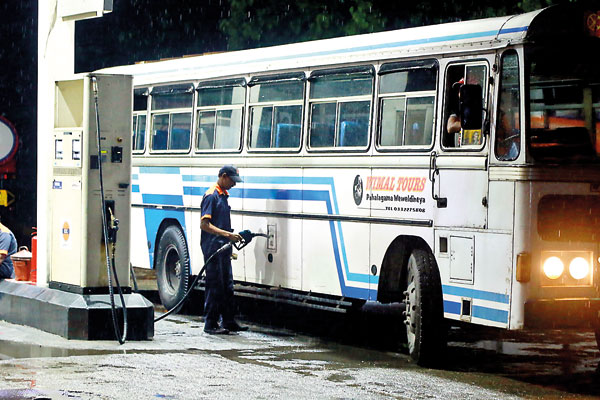News
Misuse of kerosene subsidy by heavy vehicles sparks crackdown
View(s):- Police ramp up inspections; CPC to introduce QR code for farmers and fisherfolk
By S. Rubatheesan and Kasun Warakapitiya
A large number of Sri Lanka’s heavy vehicles, including buses, run on hazardous fuel cocktails—mainly kerosene mixed with diesel and crude oil—in a cost-cutting move by operators, a Sunday Times investigation has found.
Kerosene—heavily subsidised for farmers and fisherfolk in the low-income category—is increasingly used by heavy vehicle operators to cut operating costs, although they know its long-term use damages engines and worsens environmental pollution.
To prevent engine clogging and lubrication, heavy vehicle operators use crude oil in the mix.
In the North, particularly in Kilinochchi, a recent rise in tipper-related accidents has been attributed to the use of kerosene-mixed fuel, prompting traffic police to begin checks. Police believe such fuel requires a harder press on the accelerator, increasing the risk of accidents and even vehicle fires.

Savvy bus drivers conduct their own fuel cocktail experiments. They have their own mixture ratios. Some add crude oil (bora thel) to the kerosene-diesel mix to ensure adequate lubrication to the engine. Pic by Eshan Fernando
Deputy Inspector General J.A. Chandrasena, who oversees the Kilinochchi and Mullaithivu areas, told the Sunday Times that since early this month, police had stepped up patrolling and inspection activities along the A9 highway. “It is illegal to use mixed fuel to operate vehicles. We have sent some samples taken from tippers and buses to the Ceylon Petroleum Corporation for verification.”
Kilinochchi farmers and fisherfolk allege that kerosene is often unavailable at fuel stations along the A9 road, as heavy vehicles and buses rush to stock up in large quantities as soon as bowsers arrive.
Speaking on condition of anonymity, a Palali fuel station employee revealed that tipper operators pay pump attendants an extra Rs 20 per twenty-litre can under the table for kerosene.
Since the police stepped up inspection activities, he said he could see a drop in kerosene purchased by heavy vehicle operators.
Savvy bus drivers conduct their own fuel cocktail experiments. They have their own mixture ratios. Some add crude oil (bora thel) to the kerosene-diesel mix to ensure adequate lubrication to the engine.
Central Environmental Authorities (CEA) Director R.A. Vernika Ranawaka Arachchi, who is in charge of monitoring air quality, noise and vibration, told the Sunday Times the department had not undertaken any specific research on the emissions released by vehicles that run on cocktails of different fuels.
While admitting that emissions certainly affect the air quality significantly, she said she was unable to comment on emissions released by vehicles that run on fuel cocktails.
Another senior CEA official explained that, in theory, kerosene’s low efficacy could mean less environmental damage. However, if incomplete combustion occurs, it may release carbon monoxide, a highly poisonous gas that binds to haemoglobin in the blood, reducing its ability to carry oxygen.
To prevent the misuse of kerosene subsidy, a Department of Motor Traffic (DMT) official said the Ceylon Petroleum Corporation (CPC) should introduce a QR system for farmers and fisherfolk.
He noted that the wide disparity between diesel and kerosene prices had driven bus drivers to mix kerosene with diesel as a measure to reduce their fuel expenses.
“A litre of auto diesel is Rs 277, while a litre of kerosene is only Rs 180; therefore, as there was a 97-rupee difference, bus drivers prefer to go for fuel mixing, thinking in terms of short-term cost reduction,” he said.
In its latest fuel price revision, the CPC reduced the diesel price by Rs. 6 to Rs. 277 a litre and the kerosene price by Rs. 5 to Rs. 180 a litre.
The officials called on the authorities to devise a scientific method to detect the use of kerosene in heavy vehicles.
Senior DMT officials pointed out that the Motor Traffic Act stipulated that vehicles should be registered according to vehicle prototype along with specific fuel type.
Therefore, they called for strict new regulations to make sure that motorists used the specific fuel type for their vehicles. They also called for an increase in the fines for using mixed fuel in vehicles, as the current fine of Rs. 1000 was inadequate as a deterrent.
The offenders should also be asked to pay the cost the state would incur in testing the sample from their vehicles.
Acting DMT Deputy Director General H.N. Kamal Priyatha, who heads the Environment Protection Division, said those using fuels other than those specified for the vehicle risk reduced performance and engine damage, in addition to causing harmful emissions.
The Acting Deputy Director said diesel vehicle engines are lubricated and powered by diesel, as the diesel has a property which could lubricate the engine. The ignition of the vehicle is done by compressing diesel. However, kerosene lacks these properties; therefore, when it is used, the engine does not get lubricated, resulting in wear.
He added that kerosene, unlike diesel, requires a spark to ignite. When subjected to compression without proper ignition, it causes the pistons to jerk unnaturally, damaging them over time and making the vehicle shudder.
Mr Priyantha also pointed out that internal engine parts and the engine mounts could be damaged in the long run when mixed fuels are used.
“The efficiency of those vehicles drops significantly, in addition to fuel combustion failures and the emission of harmful carbon monoxide and nitrogen oxide gases. In some cases, even non-combusted fuel vapour could be released to the atmosphere,” the acting deputy director said.
He also explained that during the emission inspection, diesel vehicles undergo an opacity test (rating the darkness of the emission and checking the amount of carbon released). Since the particles released are overlooked, there is no mechanism to measure what chemical particles are released, he said.
Therefore, he suggested the government authorities create a mechanism to analyse diesel vehicle exhaust composition and use that information to take legal action against motorists using fuel mixes.
Meanwhile, CPC said it had devised a plan to increase kerosene prices according to the price formula but would ensure through a QR code system that farmers and fisherfolk obtain subsidised kerosene. The decision was taken last week, CPC Chairman Janaka Rajakaruna told the Sunday Times.
Accordingly, kerosene prices would be increased to match diesel prices.
The CPC is incurring losses by providing kerosene at a subsidised price. The subsidy was intended for the farming and fishing community, but it is being misused by some. This is both unethical and illegal. We will not allow this kind of activity to continue,” he said.
The best way to say that you found the home of your dreams is by finding it on Hitad.lk. We have listings for apartments for sale or rent in Sri Lanka, no matter what locale you're looking for! Whether you live in Colombo, Galle, Kandy, Matara, Jaffna and more - we've got them all!

